Describe the locus of a point at a distance of 3 cm from a fixed point.
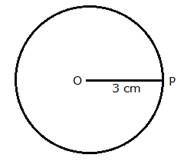
The locus of a point which is 3 cm away from a fixed point is circumference of a circle whose radius is 3 cm and the fixed point is the centre of the circle.
Describe the locus of a point at a distance of 2 cm from a fixed line.

The locus of a point at a distance of 2 cm from a fixed line AB is a pair of straight lines l and m which are parallel to the given line at a distance of 2 cm.
Describe the locus of the centre of a wheel of a bicycle going straight along a level road.

The locus of the centre of a wheel, which is going straight along a level road will be a straight line parallel to the road at a distance equal to the radius of the wheel.
Describe the locus of the moving end of the minute hand of a clock.
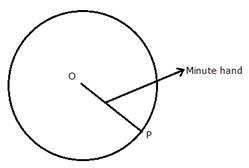
The locus of the moving end of the minute hand of the clock will be a circle where radius will be the length of the minute hand.
Describe the locus of a stone dropped from the top of a tower.

The locus of a stone which is dropped from the top of a tower will be a vertical line through the point from which the stone is dropped.
Describe the locus of a runner, running around a circular track and always keeping a distance of 1.5 m from the inner edge.
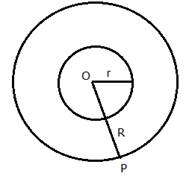
The locus of the runner, running around a circular track and always keeping a distance of 1.5 m from the inner edge will be the circumference of a circle whose radius is equal to the radius of the inner circular track plus 1.5 m.
Describe the locus of the door handle as the door opens.
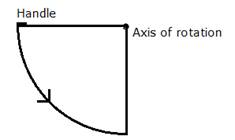
The locus of the door handle will be the circumference of a circle with centre at the axis of rotation of the door and radius equal to the distance between the door handle and the axis of rotation of the door.
Describe the locus of a point inside a circle and equidistant from two fixed points on the circumference of the circle.
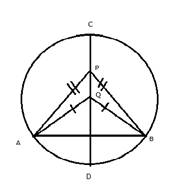
The locus of the points inside the circle which are equidistant from the fixed points on the circumference of a circle will be the diameter which is perpendicular bisector of the line joining the two fixed points on the circle.
Describe the locus of the centers of all circles passing through two fixed points.
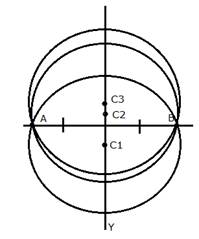
The locus of the centre of all the circles which pass through two fixed points will be the perpendicular bisector of the line segment joining the two given fixed points.
Describe the locus of vertices of all isosceles triangles having a common base.
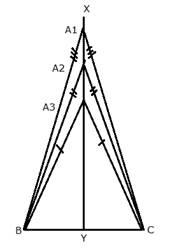
The locus of vertices of all isosceles triangles having a common base will be the perpendicular bisector of the common base of the triangles.
Describe the locus of a point in space which is always at a distance of 4 cm from a fixed point.
The locus of a point in space is the surface of the sphere whose centre is the fixed point and radius equal to 4 cm.
Describe the locus of a point P so that:
![]() , where A and B are two fixed points.
, where A and B are two fixed points.
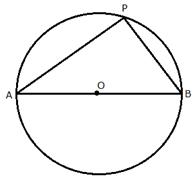
The locus of the point P is the circumference of a circle with AB as diameter and satisfies the condition ![]() .
.
Describe the locus of a point in rhombus ABCD, so that it is equidistant from
i) AB and BC
ii) B and D.
i)
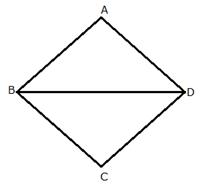
The locus of the point in a rhombus ABCD which is equidistant from AB and BC will be the diagonal BD.
ii)
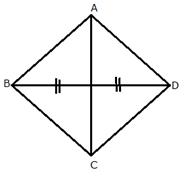
The locus of the point in a rhombus ABCD which is equidistant from B and D will be the diagonal AC.
The speed of sound is 332 meters per second. A gun is fired. Describe the locus of all the people on the Earth's surface, who hear the sound exactly one second later.
The locus of all the people on Earth's surface is the circumference of a circle whose radius is 332 m and centre is the point where the gun is fired.
Describe:
i) The locus of points at distances less than 3 cm from a given point.
ii) The locus of points at distances greater than 4 cm from a given point.
iii) The locus of points at distances less than or equal to 2.5 cm from a given point.
iv) The locus of points at distances greater than or equal to 35 mm from a given point.
v)The locus of the centre of a given circle which rolls around the outside of a second circle and is always touching it.
vi) The locus of the centers of all circles that are tangent to both the arms of a given angle.
vii) The locus of the mid-points of all chords parallel to a given chord of a circle.
viii) The locus of points within a circle that are equidistant from the end points of a given chord.
i) The locus is the space inside of the circle whose radius is 3 cm and the centre is the fixed point which is given.
ii) The locus is the space outside of the circle whose radius is 4 cm and centre is the fixed point which is given.
iii) The locus is the space inside and circumference of the circle with a radius of 2.5 cm and the centre is the given fixed point.
iv) The locus is the space outside and circumference of the circle with a radius of 35 mm and the centre is the given fixed point.
v) The locus is the circumference of the circle concentric with the second circle whose radius is equal to the sum of the radii of the two given circles.
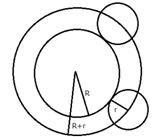
vi) The locus of the centre of all circles whose tangents are the arms of a given angle is the bisector of that angle.
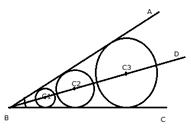
vii) The locus of the mid-points of the chords which are parallel to a given chords is the diameter perpendicular to the given chords.
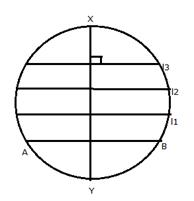
viii) The locus of the points within a circle which are equidistant from the end points of a given chord is the diameter which is perpendicular bisector of the given chord.

Sketch and describe the locus of the vertices of all triangles with a given base and a given altitude.
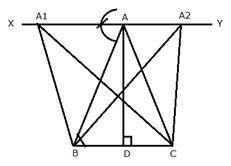
Draw a line XY parallel to the base BC from the vertex A.
This line is the locus of vertex A of all the triangles which have the base BC and length of altitude equal to AD.
In the given figure, obtain all the points equidistant from the lines m and n; and 2.5 cm from O.
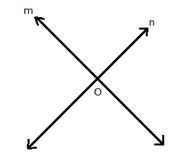
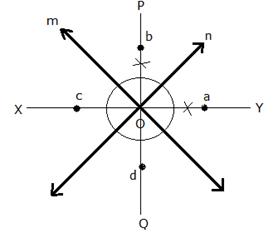
Draw an angle bisector PQ and XY of angles formed by the lines m and n. From O, draw arcs with radius 2.5 cm, which intersect the angle bisectors at a, b, c and d respectively.
Hence, a, b, c and d are the required four points.
A straight line AB is 8 cm long. Draw and describe the locus of a point which is:
i) always 4 cm from the line AB
ii) equidistant from A and B.
Mark the two points X and Y, which are 4 cm from AB and equidistant from A and B. Describe the figure AXBY.

(i)Draw a line segment AB = 8 cm.
(ii)Draw two parallel lines l and m to AB at a distance of 4 cm.
(iii)Draw the perpendicular bisector of AB which intersects the parallel lines l and m at X and Y respectively then, X and Y are the required points.
(iv)Join AX, AY, BX and BY.
The figure AXBY is a square as its diagonals are equal and intersect at 90o.
Angle ![]() and BA = BC = 8 cm. The mid-points of BA and BC are M and N respectively. Draw and describe the locus of a point which is:
and BA = BC = 8 cm. The mid-points of BA and BC are M and N respectively. Draw and describe the locus of a point which is:
i) equidistant from BA and BC.
ii) 4 cm from M
iii) 4 cm from N.
Mark the point P, which is 4 cm from both M and N, and equidistant from BA and BC. Join MP and NP, and describe the figure.

i) Draw an angle of ![]() with AB = BC = 8 cm
with AB = BC = 8 cm
ii) Draw the angle bisector BX of ![]()
iii) With centre M and N, draw circles of radius equal to 4 cm, which intersects each other at P. P is the required point.
iv) Join MP, NP
BMPN is a rhombus since MP = BM = NB = NP = 4 cm
Draw a triangle ABC in which AB = 6 cm, BC = 4.5 cm and AC = 5 cm. Draw and label:
i) the locus of the centers of all circles which touch AB and AC.
ii) the locus of the centers of all circles of radius 2 cm which touch AB.
Hence, construct the circle of radius 2 cm which touches AB and AC.
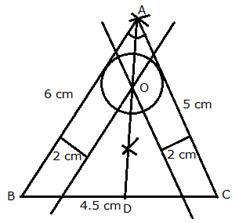
Steps of Construction:
i) Draw a line segment BC = 4.5 cm
ii) With B as centre and radius 6 cm and C as centre and radius 5 cm, draw arcs which intersect each other at A.
iii) Join AB and AC.
ABC is the required triangle.
iv) Draw the angle bisector of ![]()
v) Draw lines parallel to AB and AC at a distance of 2 cm, which intersect each other and AD at O.
vi) With centre O and radius 2 cm, draw a circle which touches AB and AC.
Construct a triangle ABC, having given AB = 4.8 cm, AC = 4 cm and ![]() . Find a point P
. Find a point P
i) inside the triangle ABC
ii) outside the triangle ABC
equidistant from B and C; and at a distance of 1.2 cm from BC.

Steps of Construction:
i) Draw a line segment AB = 4.8 cm
ii) At A, draw a ray AX making an angle of ![]()
iii) Cut off AC = 4 cm from AX
iv) Join BC.
ABC is the required triangle.
v) Draw two lines l and m parallel to BC at a distance of 1.2 cm
vi) Draw the perpendicular bisector of BC which intersects l and m at P and P’
P and P’ are the required points which are inside and outside the given triangle ABC.
Draw an angle ![]() . Find a point P such that P is at a distance of 2 cm from AB and 1.5 cm from BC.
. Find a point P such that P is at a distance of 2 cm from AB and 1.5 cm from BC.
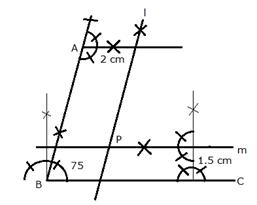
Steps of Construction:
i) Draw a ray BC.
ii) At B, draw a ray BA making an angle of ![]() with BC.
with BC.
iii) Draw a line l parallel to AB at a distance of 2 cm
iv) Draw another line m parallel to BC at a distance of 1.5 cm which intersects line l at P.
P is the required point.
Construct a triangle ABC, with AB = 5.6 cm, AC = BC = 9.2 cm. Find the points equidistant from AB and AC; and also 2 cm from BC. Measure the distance between the two points obtained.
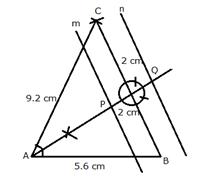
Steps of Construction:
i) Draw a line segment AB = 5.6 cm
ii) From A and B, as centers and radius 9.2 cm, make two arcs which intersect each other at C.
iii) Join CA and CB.
iv) Draw two lines n and m parallel to BC at a distance of 2 cm
v) Draw the angle bisector of ![]() which intersects m and n at P and Q respectively.
which intersects m and n at P and Q respectively.
P and Q are the required points which are equidistant from AB and AC.
On measuring the distance between P and Q is 4.3 cm.
Construct a triangle ABC, with AB = 6 cm, AC = BC = 9 cm. Find a point 4 cm from A and equidistant from B and C.
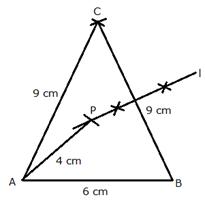
Steps of Construction:
i) Draw a line segment AB = 6 cm
ii) With A and B as centers and radius 9 cm, draw two arcs which intersect each other at C.
iii) Join AC and BC.
iv) Draw the perpendicular bisector of BC.
v) With A as centre and radius 4 cm, draw an arc which intersects the perpendicular bisector of BC at P.
P is the required point which is equidistant from B and C and at a distance of 4 cm from A.
Ruler and compasses may be used in this question. All construction lines and arcs must be clearly shown and be of sufficient length and clarity to permit assessment.
i) Construct a triangle ABC, in which BC = 6 cm, AB = 9 cm and angle ABC = 60![]() .
.
ii) Construct the locus of all points inside triangle ABC, which are equidistant from B and C.
iii) Construct the locus of the vertices of the triangles with BC as base and which are equal in area to triangle ABC.
iv) Mark the point Q, in your construction, which would make triangle QBC equal in area to triangle ABC and isosceles.
v) Measure and record the length of CQ.
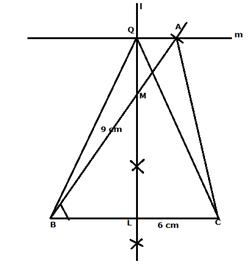
Steps of Construction:
(i) Draw a line segment BC = 6 cm.
(ii) At B, draw a ray BX making an angle 60 degree and cut off BA=9 cm.
(iii) Join AC. ABC is the required triangle.
(iv) Draw perpendicular bisector of BC which intersects BA in M, then any point on LM is equidistant from B and C.
(v) Through A, draw a line m || BC.
(vi) The perpendicular bisector of BC and the parallel line m intersect each other at Q.
(vii) Then triangle QBC is equal in area to triangle ABC. m is the locus of all points through which any triangle with base BC will be equal in area of triangle ABC.
On measuring CQ = 8.4 cm.
State the locus of a point in a rhombus ABCD, which is equidistant
i) from AB and AD;
ii) from the vertices A and C.
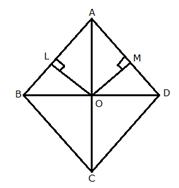
Steps of Construction:
i) In rhombus ABCD, draw angle bisector of ![]() which meets in C.
which meets in C.
ii) Join BD, which intersects AC at O.
O is the required locus.
iii) From O, draw ![]() and
and ![]()
In ![]()
![]()
![]() ( AC is bisector of angle A)
( AC is bisector of angle A)
AO = OA (Common)

Therefore, O is equidistant from AB and AD.
Diagonal AC and BD bisect each other at right angles at O.
Therefore, AO = OC
Hence, O is equidistant from A and C.
Use a graph paper for this question. Take 2 cm = 1 unit on both the axes.
i) Plot the points A(1,1), B(5,3) and C(2,7).
ii) Construct the locus of points equidistant from A and B.
iii) Construct the locus of points equidistant from AB and AC.
iv) Locate the point P such that PA = PB and P is equidistant from AB and AC.
v) Measure and record the length PA in cm.
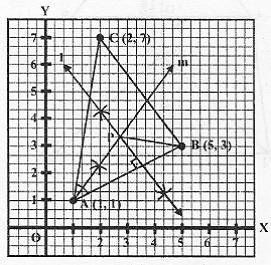
Steps of Construction:
i) Plot the points A(1,1), B(5,3) and C(2,7) on the graph and join AB, BC and CA.
ii) Draw the perpendicular bisector of AB and angle bisector of angle A which intersect each other at P.
P is the required point.
Since P lies on the perpendicular bisector of AB.
Therefore, P is equidistant from A and B.
Again,
Since P lies on the angle bisector of angle A.
Therefore, P is equidistant from AB and AC.
On measuring, the length of PA = 5.2 cm
Construct an isosceles triangle ABC such that AB = 6 cm, BC=AC=4cm. Bisect angle C internally and mark a point P on this bisector such that CP = 5cm. Find the points Q and R which are 5 cm from P and also 5 cm from the line AB.
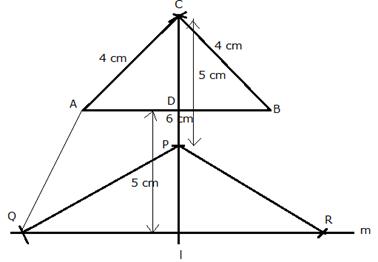
Steps of Construction:
i) Draw a line segment AB = 6 cm.
ii) With centers A and B and radius 4 cm, draw two arcs which intersect each other at C.
iii) Join CA and CB.
iv) Draw the angle bisector of angle C and cut off CP = 5 cm.
v) A line m is drawn parallel to AB at a distance of 5 cm.
vi) P as centre and radius 5 cm, draw arcs which intersect the line m at Q and R.
vii) Join PQ, PR and AQ.
Q and R are the required points.
Plot the points A(2,9), B(-1,3) and C(6,3) on a graph paper. On the same graph paper, draw the locus of point A so that the area of triangle ABC remains the same as A moves.
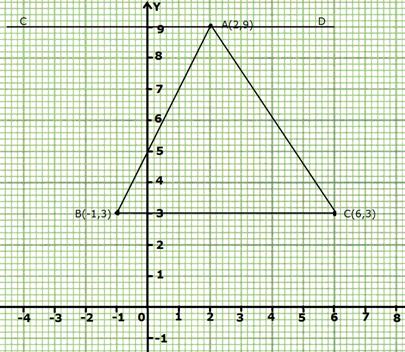
Steps of construction:
i) Plot the given points on graph paper.
ii) Join AB, BC and AC.
iii) Draw a line parallel to BC at A and mark it as CD.
CD is the required locus of point A where area of triangle ABC remains same on moving point A.
Construct a triangle BPC given BC = 5 cm, BP = 4 cm and ![]() .
.
i) complete the rectangle ABCD such that:
a) P is equidistant from AB and BCV
b) P is equidistant from C and D.
ii) Measure and record the length of AB.
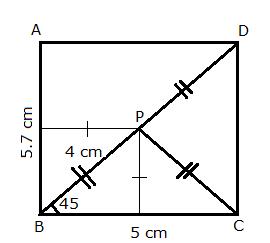
i) Steps of Construction:
1) Draw a line segment BC = 5 cm
2) B as centre and radius 4 cm draw an arc at an angle of 45 degrees from BC.
3) Join PC.
4) B and C as centers, draw two perpendiculars to BC.
5) P as centre and radius PC, cut an arc on the perpendicular on C at D.
6) D as centre, draw a line parallel to BC which intersects the perpendicular on B at A.
ABCD is the required rectangle such that P is equidistant from AB and BC (since BD is angle bisector of angle B) as well as C and D.
ii) On measuring AB = 5.7 cm
Use ruler and compass only for the following question. All construction lines and arcs must be clearly shown.
i. Construct a ΔABC in which BC = 6.5 cm, ∠ABC = 60°, AB = 5 cm.
ii. Construct the locus of points at a distance of 3.5 cm from A.
iii. Construct the locus of points equidistant from AC and BC.
iv. Mark 2 points X and Y which are at a distance of 3.5 cm from A and also equidistant from AC and BC. Measure XY.
i. Steps of construction:
1. Draw BC = 6.5 cm using a ruler.
2. With B as center and radius equal to approximately half of BC, draw an arc that cuts the segment BC at Q.
3. With Q as center and same radius, cut the previous arc at P.
4. Join BP and extend it.
5. With B as center and radius 5 cm, draw an arc that cuts the arm PB to obtain point A.
6. Join AC to obtain ΔABC.
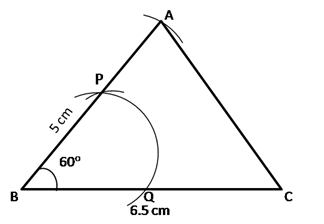
ii. With A as center and radius 3.5 cm, draw a circle.
The circumference of a circle is the required locus.
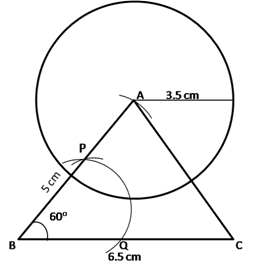
iii. Draw CH, which is bisector of Δ ACB. CH is the required locus.
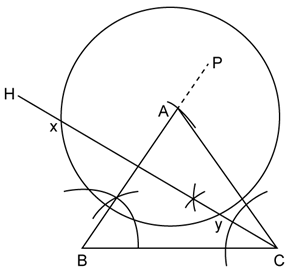
iv. Circle with center A and line CH meet at points X and Y as shown in the figure. xy = 8.2 cm
(approximately)
No comments:
Post a Comment